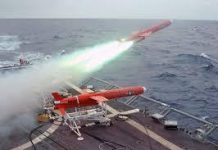
MBDA, Europe’s leading missile manufacturer, is developing a new non-line-of-sight (NLOS) missile for tanks. Known as the Akeron MBT 120, the weapon can be loaded and fired like a standard 120 mm shell, but it gives crews the ability to strike hidden targets—such as enemies behind buildings, hills, or tree cover—directly from their main gun.
According to MBDA, this innovation allows tanks to operate “in a completely different way,” improving their chances of survival by engaging hostile armor while remaining concealed. The company will showcase the missile at the DSEI defense exhibition in London, alongside several other systems, including a long-range, low-cost effector exceeding 800 km, a glide variant of the Spear air-to-surface missile, and a stealthy cruise missile under development for the UK and France through the Future Cruise/Anti-Ship Weapon (FC/ASW) program.
The Akeron MBT 120 has been shaped by battlefield lessons from Ukraine, where both sides have attempted makeshift NLOS strikes by blind-firing high-explosive rounds. Most tank battles occur under 1,500 meters, but MBDA is positioning its missile as a more reliable and cost-effective alternative. A test campaign is expected as early as next year, with deployment possible within two years, depending on demand.
Unlike Russian and Ukrainian gun-launched guided missiles, which rely on line-of-sight targeting and expose crews to return fire, Akeron MBT uses fire-and-forget guidance with a passive electro-optical/infrared seeker. This design enables it to bypass laser-warning systems and countermeasures such as Russia’s Shtora-1. Built to NATO standards, the missile is under one meter long, weighs around 20 kilograms, and fits seamlessly into existing tank turrets, including Leopard 2 and Challenger 3. It employs a rocket booster for smooth launch at low G-forces before accelerating to low-supersonic speeds.
Alongside Akeron, MBDA is unveiling Crossbow, a long-range “one-way effector heavy” weapon intended for affordable deep-strike missions. Unlike the lighter “saturation” munition presented at the Paris Air Show, Crossbow emphasizes lethality. Weighing 750 kilograms with a 5.3-meter length and 3-meter wingspan, it can carry modular payloads up to 300 kilograms, including customer-supplied warheads. Powered by a turbojet, it cruises at high subsonic speeds and exceeds 800 km in range.
Crossbow integrates AI-driven image-based navigation with satellite and inertial systems. Production costs will vary with customer requirements, particularly if higher-end subsystems are needed for contested environments. Launches will be possible from vehicles carrying standard 20-foot containers, either singly or in pairs. MBDA expects to begin demonstrations later this year, with production ready by mid-2026.
To keep prices competitive, MBDA has built a pan-European industrial base using off-the-shelf components and multiple supply chains, ensuring both resilience and scalability.
Another highlight at DSEI is the Spear Glide, a simplified, lower-cost derivative of the Spear missile. By replacing its engine and fuel with a full-caliber kinetic penetrator, the weapon achieves ranges comparable to other glide bombs (80–100 km, depending on launch). Intended mainly for fourth-generation jets like Gripen, Typhoon, and KF-21, Spear Glide is envisioned for use once adversary air defenses are degraded. Its low price point allows mass production for saturation strikes.
In addition, MBDA will demonstrate a ground-launched version of the ASRAAM missile, designed as a cost-efficient point-defense system against drones and incoming missiles, or as part of layered air-defense networks.
Finally, in relation to the FC/ASW program, MBDA will present a full-scale model of its stealthy long-range cruise missile—showing its true design for the first time. Together with a planned supersonic precision strike weapon, both missiles are slated to enter service in the early 2030s.




